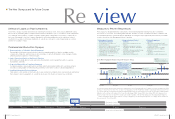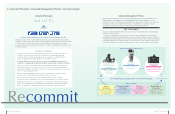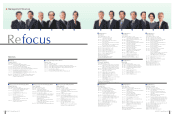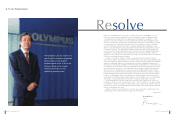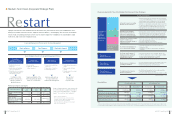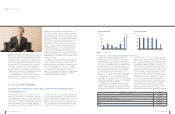Olympus 2013 Annual Report Download - page 3
Download and view the complete annual report
Please find page 3 of the 2013 Olympus annual report below. You can navigate through the pages in the report by either clicking on the pages listed below, or by using the keyword search tool below to find specific information within the annual report.
0
3,000
2,000
1,000
4,000
August 2011 January 2012 June 2012 January 2013 July 2013
2 OLYMPUS Annual Report 2013 3OLYMPUS Annual Report 2013
Re
The New Olympus and Its Future Course
1. Overconcentration of Authority in Senior Management
The president at that time possessed authority for decisions regarding selection of director candidates and the
compensation of directors, and there was an overconcentration of authority attributable to senior managers, thereby
preventing suffi cient supervision of these managers.
2. Lack of Supervisory Function of the Board of Directors
Both inside and outside directors were selected by the president, which impeded their ability to supervise
management objectively.
3. Corporate Culture with Low Compliance Awareness
Compliance awareness was exceptionally low, and there were Companywide problems with corporate governance
structures, including neglect for internal reporting and internal control divisions without suffi cient independence.
4. Insuffi cient Information Disclosure Systems
There were no solid systems for information disclosure, and decisions related to disclosure were made arbitrarily by
the Company’s senior management. As a result, the disclosure of information for investors was insuffi cient.
Problems Identi ed within Olympus
In the 1990s, Olympus incurred substantial losses stemming from fi nancial assets. The Company deferred recording
these losses by transferring them to multiple funds that existed outside the scope of consolidation. It then overpaid fees
associated with the acquisitions of certain companies, diverting these overpayments to the funds to compensate for
the losses. Subsequent to that, the Company attempted to resolve the unrealized losses through the recording of
amortization of goodwill on its fi nancial statements. As a result, we continued to conduct inappropriate accounting
practices for a number of years.
Deferral of Losses on Past Investments
• Losses on investment in
fi nancial assets expand
following the collapse of
Japan’s bubble economy.
• Prior to the introduction
of market value account-
ing in April 2000, unreal-
ized losses on the
relevant fi nancial assets
had been separated from
the consolidated ac-
counts by transferring
them to multiple funds
at book values.
• The off-balance-sheet
losses are eliminated by
taking advantage of the
purchase of three domes-
tic subsidiaries.
• Deferred recording of past
losses is discovered.
• The Third Party Committee
is established to investi-
gate the issue.
• The investigation report is
received from the Third
Party Committee.
• The committee explains the
need to improve gover-
nance and take steps to
prevent recurrences.
• The Company establishes
the Management Reform
Committee, the Director
Liability Investigation
Committee, and the
Non-Director Liability
Investigation Committee.
• The reports of the Director
Liability Investigation
Committee and the
Non-Director Liability
Investigation Committee
are received, and a suit for
damages is fi led against
past managers.
• The Company’s stock is
designated by the TSE
as a Security on Alert
(January 21).
April 2012March 2012
Clari cation of
improvement
measures
January 2012December 2011November 20112008 – 20101990s June 2012
The Company has established internal scrutiny teams, which have developed the following measures to prevent the
reoccurrence of such issues. In formulating these measures, the teams took into consideration the areas of weakness and
recommended measures to prevent recurrences identifi ed in an investigation report prepared by the Third Party Committee
as well as the advice of the Management Reform Committee.
1. Strengthen Corporate
Governance Structure
• Clear separation of executive and
supervisory functions
• Reinforcement of supervisory authority and
functions over executive functions
• Fairness in selection of outside directors and
audit & supervisory board members, and
expansion of the roles and functions of
outside directors and audit & supervisory
board members
• Active disclosure of information
2. Improve Internal Control
Systems
• Improvement of internal checks and
balances
• Appropriate management of business
investments, subsidiaries, and affi liated
companies
• Prevention of fraudulent activities through
improvements to human resource
management systems
• Enhancement of internal audits
3. Review Compliance
Systems
• Improvement of management team’s
compliance awareness, and establishment
of clear accountability
• Establishment of systems to support
further reinforcement of compliance
promotion
• Fostering of consistent awareness of
compliance
• Improvement of whistle-blowing systems
Measures to Prevent Recurrences
view
May 2012
Internal system development period
Development of regulations
Development of system
In conjunction with the discovery of the deferred recording of past losses in November 2011, the Company’s stock price plummeted to ¥424
per share, its lowest level ever. Since then, we have received guidance from the Third Party Committee and formulated measures to prevent
reoccurrence while also revising internal systems and implementing an array of other initiatives. As a result, we were able to submit a written
affirmation on the internal control system to the Tokyo Stock Exchange (TSE) in January 2013. Later, in May 2013, the Company’s stock
price recovered to the level seen before the scandal came to light, regardless of the fact that Olympus was still undergoing investigations.
Further, immediately after the issues surfaced, coverage of Olympus by sell-side analysts dropped to one company, but the number has
since recovered to 11 as of July 2013.
Stock Price Changes from Discovery of the Issues to Today
(¥)
Low (Nov. 11)
¥424
April 2012
• A special general meeting of
shareholders is convened.
• A new management team is
appointed and all members of the
old management team resign.
January 2012
• Security under Supervision
designation is cancelled, and the
Company’s stock is designated
Security on Alert (January 21).
January 2013
• Submission of written affi rmation on
the internal control system to TSE.
July 2013
• Plan to offer new shares and
existing shares of treasury stock
to overseas investors is approved.
June 2012
• The medium-term vision (corpo-
rate strategic plan) geared toward
creating a new Olympus is announced
by the new management team.
High (May 23)
¥3,570



